Top Causes of Potato Blight and How to Identify and Prevent Them
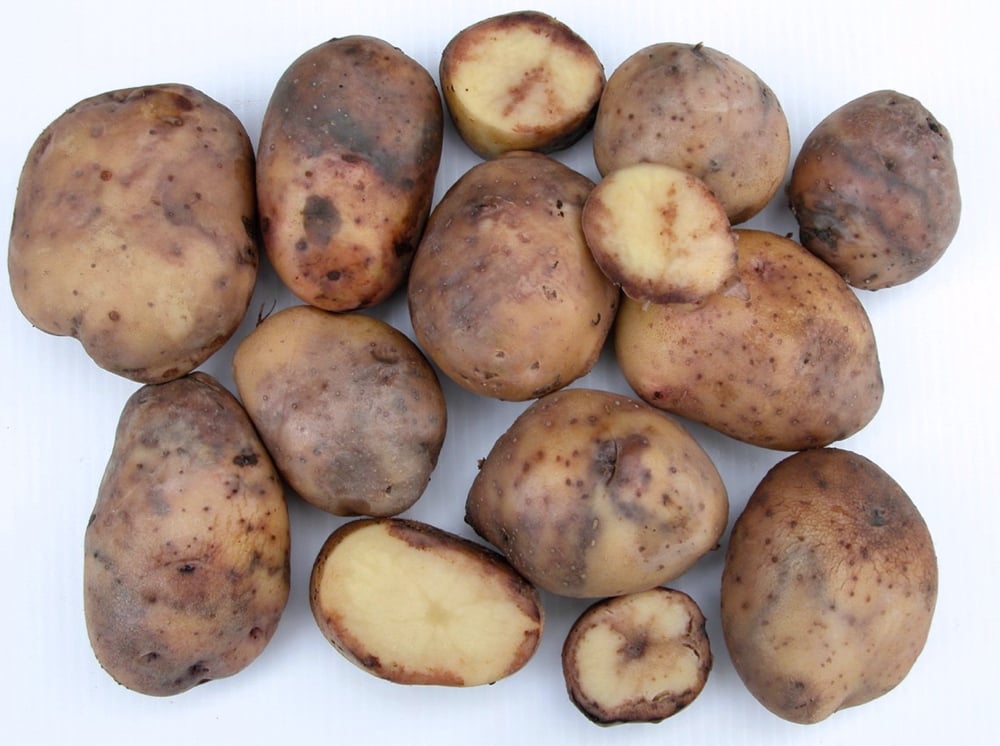
Table of Contents
Potato blight is a serious fungal disease that affects potato plants, leading to significant yield loss and economic damage to farmers. This disease is caused by the fungus Phytophthora infestans which can spread rapidly in cool, wet weather conditions and is characterised by brownish-black lesions on the leaves and stems of potato plants. In severe cases, the disease can spread rapidly and destroy the entire potato crops.
Potatoes are a staple crop in many countries and play a crucial role in food security and economic development. A single outbreak of potato blight can devastate entire fields, leading to a significant reduction in production and quality and ultimately impacting food availability and prices.
Hence, this article aims to provide a comprehensive overview of the causes, identification, and treatment of potato blight.
Stay tuned! If you’re interested in understanding and addressing the challenges posed by potato blight.
Causes of Potato Blight
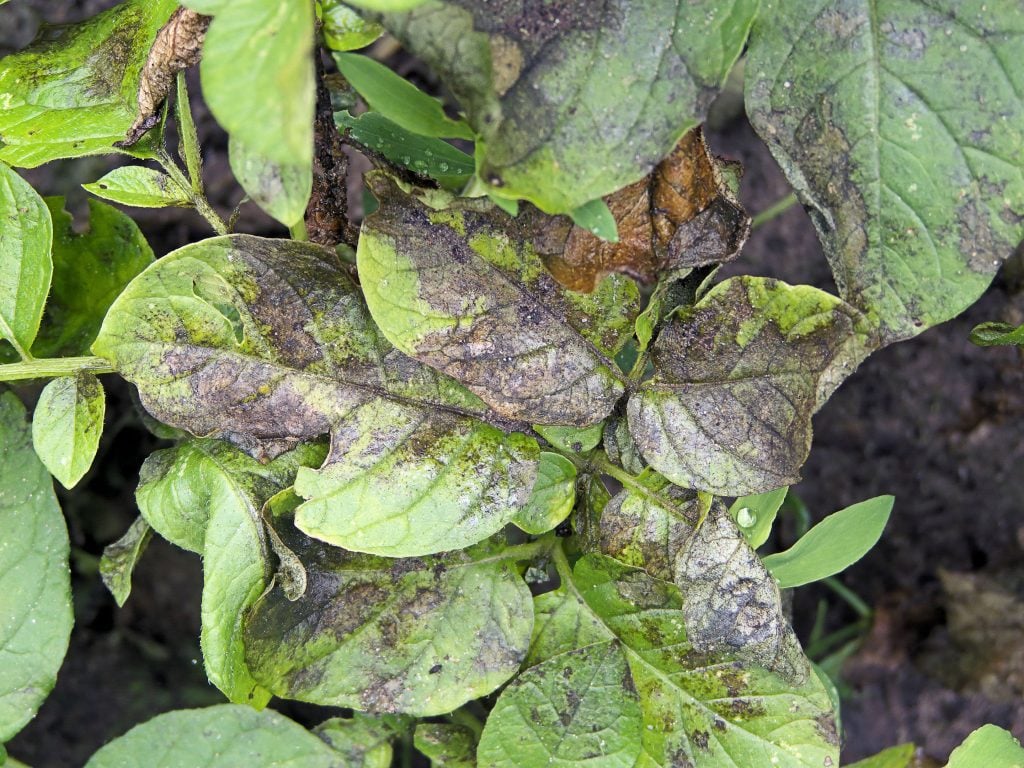 />
/>
Potato blight, which is also known as late blight, can be devastating, leading to significant yield losses and even complete crop failure. Let’s explore the causes of potato blight, including the role of Phytophthora infestans and environmental factors.
1. Phytophthora Infestans
Phytophthora infestans is a fungus-like organism that is the primary cause of potato blight. This organism thrives in cool and moist conditions, making it prevalent in regions with wet and humid climates. It spreads rapidly, especially in warm and wet weather, and can infect potato plants at any stage of growth.
This pathogen typically attacks the leaves of the plants, causing them to develop water-soak spots that rapidly turn into brown lesions. These lesions can quickly spread, and within a matter of a few days, the entire leaf can be infected. The disease then spreads to the stems and eventually to the tubers, causing them to rot.
Phytophthora infestans spread through spores that are released from infected plants and can travel long distances through the air. The spores can also be carried by rain, wind, and insects, allowing the disease to spread quickly.
2. Environmental Factors
Several environmental factors are responsible for the development and spread of potato blight. The three significant factors are temperature, humidity, and rainfall.
- Temperature: Temperature plays an important role in the development of potato blight. The pathogen thrives in cool and moist conditions, making it prevalent in regions with moderate temperatures. Optimal temperatures for the growth and spread of Phytophthora infestans are between 12°C and 24°C.
- Humidity: Humidity is another crucial factor that affects the development and spread of late blight in potato plants. Phytophthora infestans thrives in humid conditions, making it prevalent in regions with high humidity levels. When humidity levels are high (above 90%), the spores are more likely to germinate, and the disease can spread rapidly.
- Rainfall: Rainfall is another environmental factor that influences the development of potato blight in potato plants. The disease thrives in wet conditions, making it prevalent in regions with high rainfall. However, when rainfall is excessive, the spores can be washed away, reducing the spread of diseases.
Identification of Potato Blight
It is essential to identify potato blight early to prevent significant crop losses. Here, we’ll discuss the symptoms of potato blight and the diagnostic techniques used to identify this disease.
1. Symptoms of Potato Blight
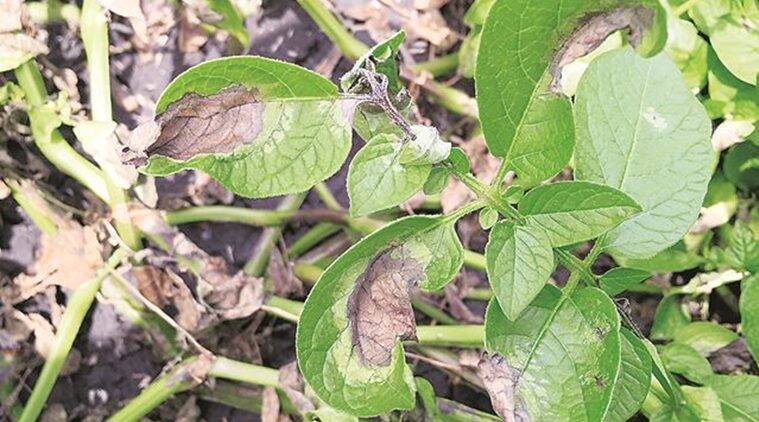
When it comes to identifying potato blight in potato plants, looking for symptoms in various parts like leaves, stems, and tubers is one of the ways. Let’s look deeply at the symptoms of this disease in these parts of plants.
- Leaf Symptoms: The first symptoms of potato blight typically appear on the leaves of the plant. Initially, small, water-soaked lesions appear on the lower leaves of the plant, often near the soil surface. As the disease progresses, the lesions become prominent and turn brown. The lesions can spread rapidly, causing the entire leaf to turn brown and die.
- Stem Symptoms: As the disease transfers from leaves, it attacks the stems of the potato plant. The stems may develop dark brown or black lesions, which can cause them to wilt and die. The stems can also develop cankers, which can girdle them, causing the plant to die.
- Tuber Symptoms: The final symptoms of potato blight typically appear on the tubers of the plant. The disease can cause the tubers to rot, reducing their quality and yield. The infected tubers may have a soft, watery appearance with a foul odour. The flesh of tubers may also turn brown or black and may have a slimy texture.
2. Diagnostic Techniques
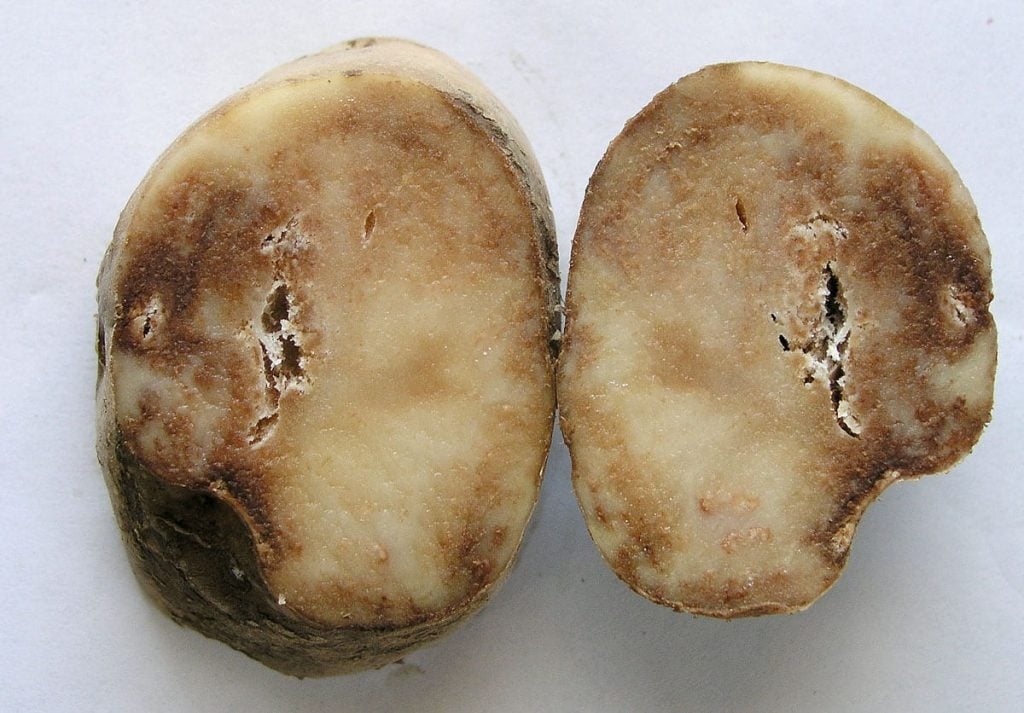
There are two common diagnostic techniques to identify potato blight. The first is visual diagnosis, and the second is laboratory diagnosis.
- Visual diagnosis: Visual diagnosis is the most common diagnostic technique used to identify potato blight. A visual examination of the plant can reveal the characteristic symptoms of the disease, including leaf lesions, stem cankers, and tuber rot. It is important to examine the plant at different stages of growth to ensure that the disease is accurately identified.
- Laboratory diagnosis: Laboratory diagnosis is an advanced way to confirm the presence of potato blight. The most common laboratory technique is the ELISA (enzyme-linked immunosorbent assay) test. Another laboratory test used to identify potato blight is the PCR (polymerase chain reaction) test. In addition to these lab tests, farmers and gardeners can also use their smartphone apps to identify potato blight. These apps use image recognition technology to analyse pictures of potato leaves and can quickly identify the presence of the disease.
Overall, it is essential to accurately identify potato blight to prevent them from causing large-scale damage to crops. By understanding the symptoms of potato blight and the diagnostic techniques available, farmers and gardeners can take appropriate measures to control the disease and prevent its spread.
Treatment of Potato Blight
Potato blight is caused by the fungus Phytophthora infestans and can affect both the foliage and the tubers of the plant. Let’s dive into the treatment of potato blight, focusing on cultural practices, chemical control, and biological control.
1. Cultural Practices
Cultural practices are an essential component of potato blight management, as they can help prevent the disease from occurring in the first place or reduce its severity. Some of the cultural practices that can be used to manage potato blight include crop rotation, planting dates, and irrigation management.
- Crop Rotation: Rotating potato crops with other crops such as cereals, legumes, or grasses can help reduce the buildup of the pathogen in the soil. It is recommended to rotate potato crops every three to four years.
- Planting date: Planting potatoes earlier in the season can help reduce the risk of potato blight, as the disease tends to be more prevalent in warm, moist conditions that occur later in the season.
- Irrigation management: Overwatering can create conditions that are favourable for the development and spread of potato blight. It is recommended to irrigate potatoes only when necessary and to avoid watering late in the day.
2. Chemical Control
Chemical control options are also available for managing potato blight. Fungicides can be applied preventively or curatively to control this disease. However, it is essential to use fungicides responsibly, as overuse can lead to the development of fungicide-resistant strains of the pathogen. Some of the fungicides that are commonly used to control potato blight include copper sulphate, metalaxyl, and chlorothalonil.
3. Biological Control
Biological control options for potato blight involve the use of natural enemies, including bacteria, fungi, and viruses that are harmful to the fungus-like organism. The most common biological control options are Bacillus subtilis and Trichoderma harzianum. Bacillus subtilis is applied preventatively and works by colonising the plant roots and preventing the fungus-like organism from infecting the plant.
Prevention of Potato Blight
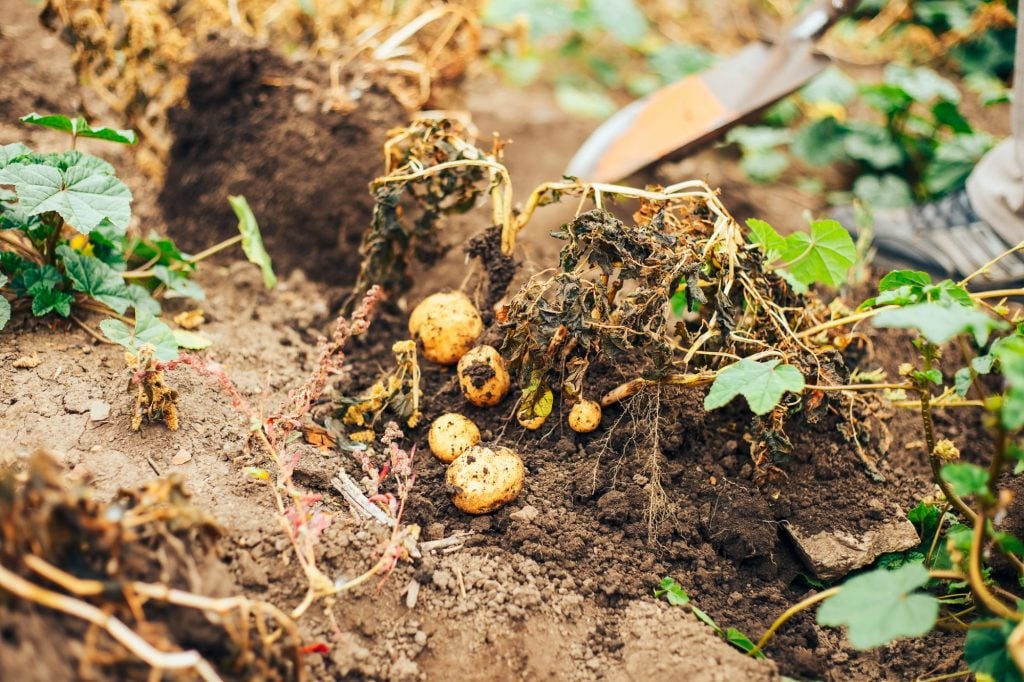
Preventing Potato blight is crucial to ensuring a healthy potato crop and reducing the risk of yield losses. Let’s discuss some best practices and precautionary measures for preventing potato blight.
1. Best Practices for Preventing Potato Blight
The best practices for preventing potato blight are going for plant disease-resistant varieties and timely harvesting. Choosing potato varieties that are resistant to potato blight will help reduce the risk of the disease spreading in the crop. Harvesting the potato crop before the weather becomes wet and cool, which is favourable for the spread of the disease, can also prevent this disease.
2. Precautionary Measures
Some of the precautionary measures for reducing the risk of potato blight are regular inspection, sanitation, and quarantining potatoes.
- Regular Inspection: Inspect the potato plants regularly for signs of the disease, and remove any infected leaves or tubers.
- Sanitation: Remove any diseased potato plants and tubers from the field and dispose of them properly.
- Quarantine: Do not bring in potato plants or tubers from other areas without first ensuring that they are disease-free.
Preventing potato blight requires a combination of best practices and precautionary measures. By following these measures, potato growers can reduce the risk of late blight and ensure a healthy potato crop.
Addressing Challenges Posed by Potato Blight
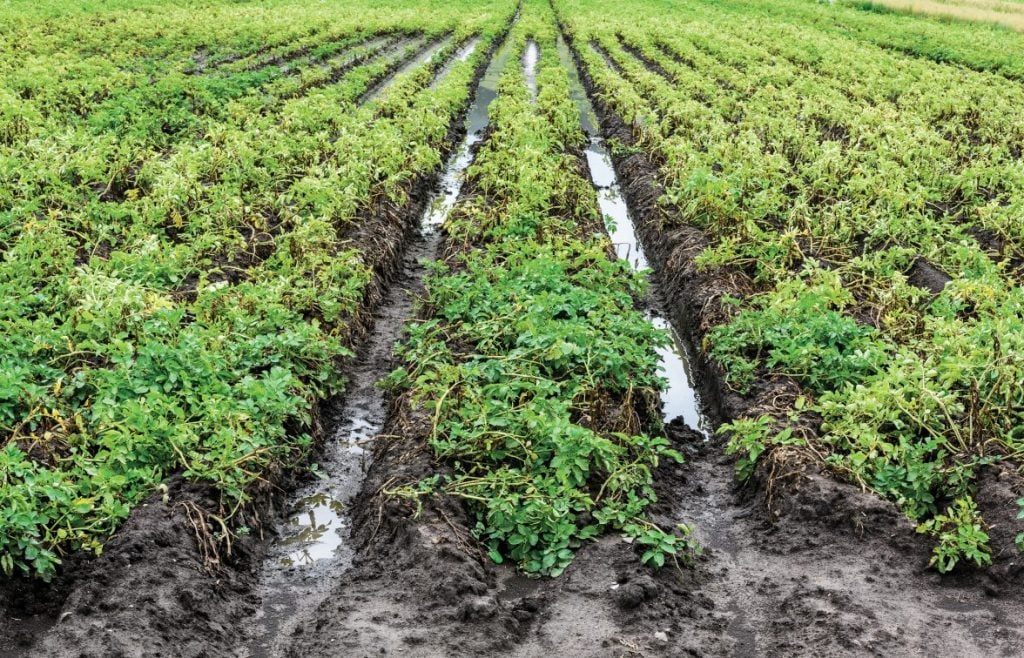
Potato blight is a potential threat to potato crops worldwide and can have severe economic and food security implications. In this article, we have explored the cause, that is, Phytophthora infestans. The key to managing potato blight is to combine different control methods, such as cultural practices, chemical treatments, and biological control agents, to prevent the disease’s spread and minimise its impact. We have also learned the importance of preventive measures, such as using disease-resistant potato varieties and timely harvesting of potato crops.
To address potato blight, it is essential to involve all stakeholders, including farmers, extension agents, researchers, policymakers, and industry players. There is a need for increased investment in research to develop more effective and sustainable control methods, disease-resistant potato varieties, and early warning systems.
By working together, the impact of potato blight can be minimised, and food security for the future can be secured.
Frequently Asked Questions
What Causes Potato Blight?
Potato blight is caused by a fungus – Phytophthora infestans. It thrives in warm, moist conditions and spreads easily through potato fields. The fungus produces spores that are easily transported by wind and rain, making it difficult to control. Once it infects a potato plant, it causes brownish-black lesions on the leaves and stems, eventually leading to the plant’s death.
How Do You Identify Potato Disease?
Potato blight can be identified through physical symptoms on the plant, such as brownish-black lesions on the leaves and stems, leaf yellowing, and wilting. Laboratory tests can also be used to confirm potato blight in plants. Early detection and identification of the disease are crucial for effective management and prevention of spread.






